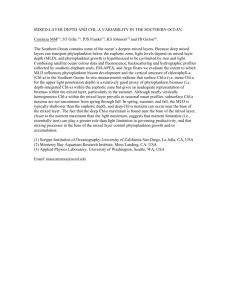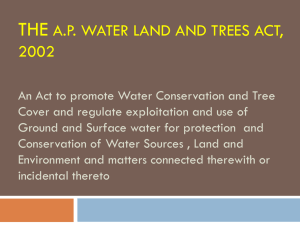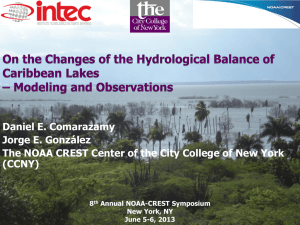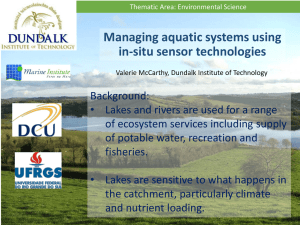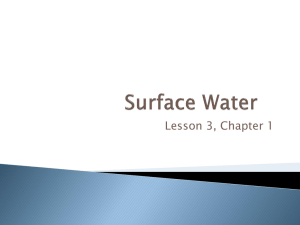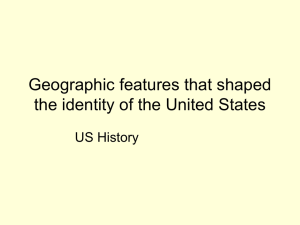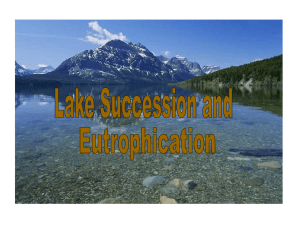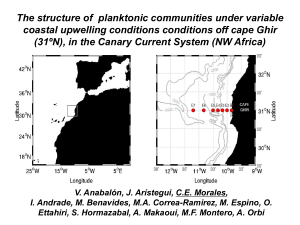Global Observatory of Lake Responses to Environmental Change
advertisement
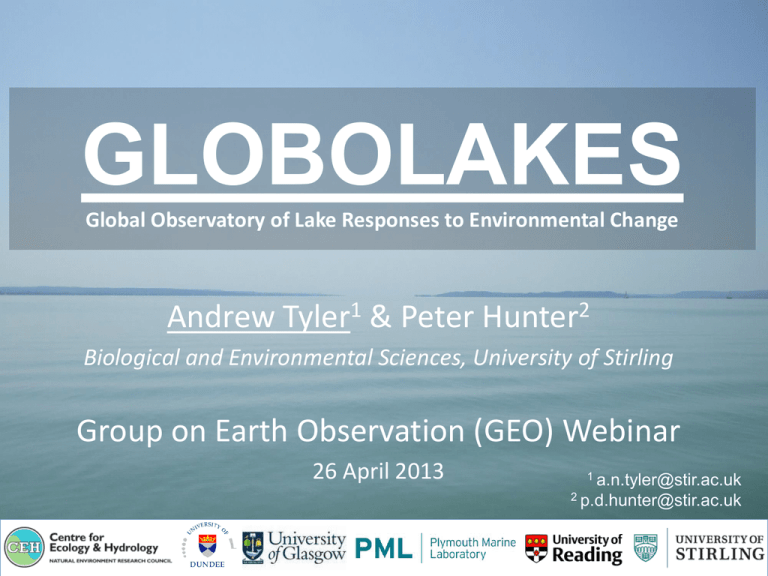
GLOBOLAKES Global Observatory of Lake Responses to Environmental Change Andrew Tyler1 & Peter Hunter2 Biological and Environmental Sciences, University of Stirling Group on Earth Observation (GEO) Webinar 26 April 2013 1 a.n.tyler@stir.ac.uk 2 p.d.hunter@stir.ac.uk • • • • • • Research Rationale Aims and Objectives Data Acquisition Lake Selection Coherence in Lake Response Summary The Consortium Andrew Tyler, Peter Hunter, Evangelos Spyrakos: University of Stirling, UK Steve Groom, Victor Vicente-Martinez, Gavin Tilstone, Giorgio Dall’Olmo: Plymouth Marine Laboratory, UK Christopher Merchant, Stuart MacCallum: University of Edinburgh/University of Reading, UK Mark Cutler, John Rowan, Terry Dawson, Eirini Politi: University of Dundee, UK Stephen Maberly, Laurence Carvalho, Stephen Thackery, Alex Elliott: Centre for Ecology & Hydrology, UK Claire Miller, Marion Scott: University of Glasgow, UK Rationale • >300 million lakes globally • Providing essential ecosystem goods & services • Fundamental to global food security • Global concerns over future water security (Unsustainable use; MEA 2005) • Important in global biogeochemical cycling (Bastviken et al. 2011, Science) Geographic distribution of the world’s 200 largest lakes. Data courtesy of ESA-funded ARCLakes project (PI Christopher Merchant, University of Edinburgh) Rationale • Lakes are ‘sentinels’ of environmental change • These can trigger internal interactions & direct responses leading to: – – – – loss of habitat eutrophication fish kills loss of species (highest proportion of species threatened with extinction; MEA 2005) – altered communities & shifts to less desirable species Rationale SeaWifs: 1997-2010 Timeliness: • Increasing robustness of algorithms and ensemble approaches • Capability for processing huge data volumes in near real time • MERIS: spectral and temporal resolution (until April 2012) • GMES: ESA planned launches – superior capabilities (2014) Opportunity: Access to nearly 20 years of data on 1000 lakes of different types across the globe will give a paradigm shift in our ability to ask fundamental ecological questions in relation to the status and change in the condition of the world’s lakes MERIS: 2002-2012 Sentinel: 2 2014 Sentinel: 3 2014 Questions What controls the differential sensitivity of lakes to environmental perturbation? Some pressing questions: • What is the present state & evidence for long-term change for the 1000 lakes? • To what extent are patterns temporally coherent & what are the causes? • Is there evidence for phenological change & what are the causes? • What factors control cyanobacterial blooms? • What factors control the concentration of coloured DOC? • How sensitive are different lake types to varying environmental perturbation? • Can we forecast the future response of phytoplankton composition & abundance, & risk of cyanobacterial blooms, for lakes in different landscapes? Aims and Objectives Derwent Water Investigate the state of lakes & their response to environmental change drivers: • Near real time processing satellite based observatory • Processing archived data for up to 20-year time series • Including: (i) LSWT; (ii) TSM; (iii) CDOM; (iv) Chl a; (v) PC • Detect spatial & temporal trends & attribute causes of change for 1000 lakes worldwide (1/3 of inland water, 2/3 of all inland water > 1km2) • Forecast lake sensitivity to environmental change • Apply findings into lake management Lake Balaton Ice Cover Project structure WP1 and WP2 • Selection and operationalization of algorithms for retrieval of lake biogeochemical properties • Initially MERIS archive, but later Sentinel-3 OLCI • Extension of global lake surface water algorithms (from ArcLakes) to smaller lakes (ATSR & SLSTR) • In situ data from research cruises, long-term monitoring programmes and instrumented buoys WP2: Operational processing WP1: Algorithm validation Study lakes Level 1 Case study lakes (~15) Intensive field campaigns to test algorithms Testing In situ optics and biogeochemical validation data UK lakes plus selected international lakes with good data availability (IOPs, AOPs, in situ data for MERIS match-ups) study lakes Refining Level 2 International lakes (~50) Validation of most promising algorithms using partner data sets from contrasting lakes Validation Level 3 Global lake population (~1000) Operationalization of selected algorithms In situ biogeochemical validation data: UK; Estonia; Hungary, Italy; Spain USA; Canada; Australia; South Africa, Kenya, High temporal resolution buoy data UKLEON – NERC funded buoy sensor network GLEON – NSF funded international buoy sensor network Level-2/-3 products delivered to end-users Time-series biogeochemical data provided to project partners and end-users GloboLakes data Partner data Atmospheric correction Additional credits: Stephanie Palmer, Jose Antonio Dominguez, Brockmann Consult Chlorophyll algorithms Chla mg m-3 Fluorescence = 0.75 RMSE = 4.3 mg m3 Bias= 0.5 mg m3 20 10 0 10 0 40 10 20 30 Lab-analyzed Chl-a (mg m-3) 40 R2 = 0.41 RMSE = 8.1 mg m3 Bias= -4.5 mg m3 20 10 0 10 10 20 30 Lab-analyzed Chl-a (mg m-3) 40 FUB/WeW Chl-a 120 R2 = 0.64 RMSE = 15.9 mg m3 Bias= 6.7 mg m3 105 90 75 60 45 30 15 0 0 Case C2R Chl-a2 Regional 30 MERIS-derived Chl-a (mg m-3) MERIS-derived Chl-a (mg m-3) 20 R2 = 0.65 RMSE = 4.9 mg m3 Bias= -0.001 mg m3 20 0 R2 = 0.42 RMSE = 7.3 mg m3 Bias= -0.8 mg m3 30 0 30 40 Boreal Lake Boreal Lake Chl-a 40 MERIS-derived Chl-a (mg m-3) 10 20 30 Lab-analyzed Chl-a (mg m-3) MERIS-derived Chl-a (mg m-3) R2 30 0 Maximum Chlorophyll Index 40 L1b FLHHeight Chl-a Line MERIS-derived Chl-a (mg m-3) MERIS-derived Chl-a (mg m-3) 40 40 15 30 45 60 75 90 105 120 Lab-analyzed Chl-a (mg m-3) Eutrophic LakeLake Chl-a Eutrophic 30 R2 = 0.38 RMSE = 8.2 mg m3 Bias= -4.4 mg m3 20 10 0 0 0 10 20 30 Lab-analyzed Chl-a (mg m-3) 40 0 10 20 30 Lab-analyzed Chl-a (mg m-3) 40 Additional credits: Stephanie Palmer, Astrium LIMNADES • Lake bIo-optical MeasuremeNts And matchup Data for rEmote Sensing (LIMNADES) • LIMNADES provides a repository for: 1) inherent and apparent optical properties for algorithm development 2) in situ water constituents measurements for algorithms validation • Vision is to provide long-term archive running beyond lifetime of GloboLakes • Find out more: www.globolakes.ac.uk/limnades LIMNADES Partners Quality control Related projects Other contributors/users Uncertainties Privately shared Publicly shared DATA ACCESS & POLICY: http://www.globolakes.ac.uk/limnades/data_access_policy.html LIMNADES GloboLakes partner lakes Other data contributed to LIMNADES (Apr 2013) WP3: Lake selection Lake Landscape Context (after e.g., Sorrano et al. 2009) • Incorporate a wide range of catchmentto-lake-surface-area ratios • Span a wide range of water quality parameters and ecological characteristics, e.g. pH, alkalinity, eutrophication status and mixing regime • Include lakes of special scientific interest • Ideally a pool from which lakes selected using a randomised, probability-based approach (Stevens 1994). Global lake population Currently 1,811 under consideration WP3: Drivers of change • Spatial database of drivers of catchment change, including: – – – – – – climate land cover catchment morphology productivity development lake hydromorphology etc. • Trends in catchment change derived from global datasets (30 years of change) • Run-off modelled for each catchment using a lumped GISbased model WP3: Catchment data Road network River network & Dams Climatic ecoregions Soil type NDVI Land cover Annual mean temperature Annual mean precipitation Elevation Case Study: ARC-Lake data LSWT Time Series (257 standardized LSWT time series) Finazzi, F., Miller, Cl., Scott, M. Case Study: ARC-Lake data Clustering Result Finazzi, F., Miller, Cl., Scott, M. Case Study: ARC-Lake data Clustering Result – Global map Finazzi, F., Miller, Cl., Scott, M. Engagement Success of GloboLakes will rely on contributions from across the EO and end-user communities • More than 20 scientific partners from over 15 nations • CSIRO, Australia; CSIR, South Africa; VITO, Belgium • Environment Canada; Estonian Marine Institute; • EC Joint Research Centre; CNR-IREA, Italy; • INTA, Spain; CUNY, USA; Creighton, USA • South Florida, USA; Institute of Limnology, Nanjing… • Engagement with end-users including UK environmental regulators (EA, SEPA, NIEA) • Engagement with UK National Centre for Earth Observation (NCEO), European Environment Agency, ESA and GEO Linkages and Developments • Brockmann Associates • Lake Algal Bloom Pilot Project • KTAMOP: Ecological Status and Function of Lakes (Hungarian Academy of Sciences) – HICO (Hypespectral Imager of the Coastal Ocean) • Validation team for ESA Sentinel 3 • • INFORM: Improved monitoring and forecasting of ecological status of European Inland waters by combining Future earth ObseRvation data and Models (FP7 project pending): VITO, Belgium GLaSS: Global Lakes Sentinel Services: Water Insight, Wageningen • DANCERS: DANube macroregion: Capacity building and Excellence in River Systems (basin, delta and sea): GeoEcoMar, Romania • CYANOCOST: Training and networking for EO • NETLAKE: COST Action for in-situ sensors www.globolakes.ac.uk Thank you!
